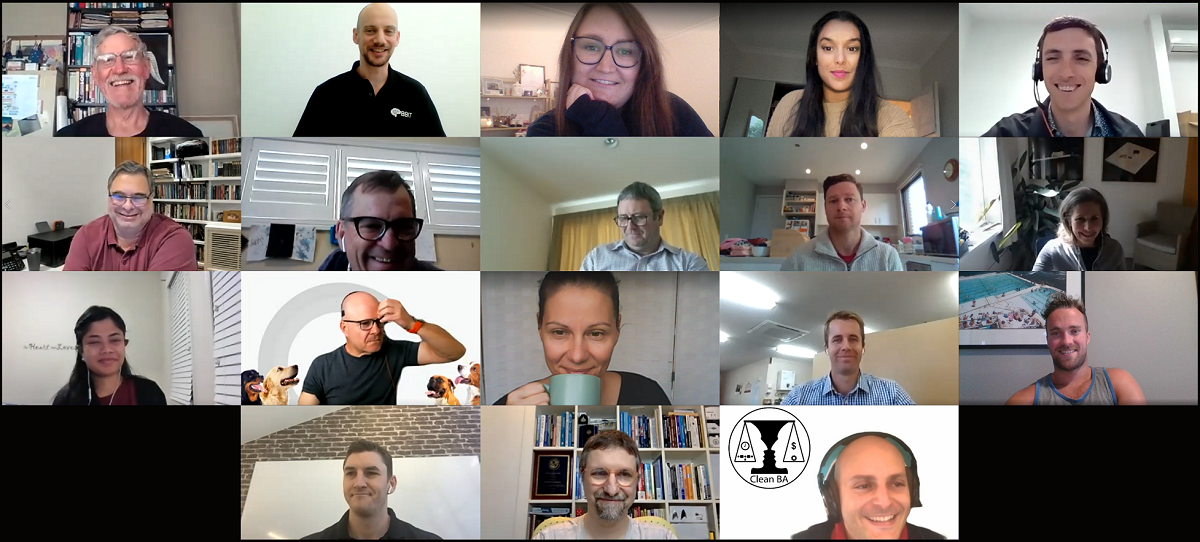In Part 1 of the series, I covered the key elements of the Black Belt in Thinking (BBIT) Boot Camp that make it unique and easily developed into an online course. Here, we’ll see if these are true.
We knew Covid-19 would be a major catalyst for many businesses to fully embrace the digital age. A major part of the BBiT course is challenging your own assumptions about the way things are or need to be. And sometimes, external factors force people to do things they otherwise wouldn’t. We would have never thought we could train people online. A major part of the magic was the event itself. It wasn’t easy but here we are.
Online-onward, we went
So, how did we recapture this magic in an online format? We knew being a ‘normal’ online course wouldn’t cut it because the course itself is not ‘normal’.
We were worried about people showing up online, listening half-heartedly to some videos, and then, not finishing the course. Some may even leave with a few new ideas but ultimately, don’t change anything they do. People who did the face-to-face BBIT Boot Camp not only learned tools to a level of competency, but also solve real problems with them and leave with a changed way of thinking. Huge difference. On the other hand, we knew online courses presented opportunities not present in the in-person courses. The cohorts could become much larger, with people from anywhere in the world attending. The leverage could reduce prices, making the course more accessible than ever. A broken-down structure would allow both the benefits of spaced learning and the opportunity to apply and solve real-world situations as we went with the tools, rather than solving and planning without the opportunity to implement. Incorporating the benefits, while replacing the downsides with upsides was the new focus.
Videos are on-demand
By far, one of the best ways to provide engaging, remote learning experiences is to use video. We began our first shot at video production by filming me teaching while using a whiteboard and a lot of excited gesturing – much like how I would on an in-person course. The first group of participants provided positive feedback but also had concerns with both the readability of the writing and the awkward pauses when I was writing. We decided then to insert graphic overlays. This gave us the best shot of an engaging presentation by way of graphics to make clear the points and examples of the videos.
Self-marked exercises
Being a skill-transfer (training) course rather than a knowledge-transfer (education) course, we needed exercises. The moment we stepped into this side of things, we encountered a conflict: Do we provide more hands-on kind of training to increase skill, or less to keep the fees down? Basically, how do we create leveraged training that doesn’t diminish skill while keeping fees down?
We differentiated ‘exercises’ from ‘application’, in that exercises are practiced on example situations. This meant participants were able to mark their own exercises, not only providing the learning outcome but also kept the leverage up.
Maintaining flow
We quickly learned there was another driver for self-marked workflow. To maintain flow to the course, which was critical for success, we had to minimise the forced stop points. Of course, necessary reviews and feedback from instructors were the only real stop points. While we focused on fast turnaround, the different time zones made it difficult. Therefore, we tried to create an effective cycle of reviewing work quickly to get it back to participants while the work is still fresh in their heads, ensuring they’re on a roll. Practice doesn’t make perfect; practice makes permanent. So, we needed to ensure people’s skills improve with consecutive and consistent practice.
The end of a week is certainly the busiest time for instructors but that also means they have a lighter early week, ensuring regularity. While leverage is a focus of an online course to keep costs down, as participant numbers rise, we can scale accordingly.
Make it live and lively
One of the most apparent downsides of online courses is that group learning benefits of classroom environments aren’t there. So, the first thing we tackled was to make sure participants learned from questions and examples posed by others. We created a couple of time slots each week for people to come along and ask any questions they had. This included theory questions and working through some of their situations. This is an example where the leverage of an instructor working with a group is also more beneficial than one-on-one because everyone could learn from each other.
Community-based learning
With running a virtual classroom, we now had people from all over the world in many various situations trying to find solutions – a community of problem-solvers, if you like. It is crucial that this community get together and learn from each other’s point of view, simply because one of our most limiting factors in learning and problem-solving is availability bias. Our brain doesn’t know what it doesn’t know. This can lead us to assume that tools can only be applied in the ways we have applied them or seen them applied.
So, we made sure that one of the introductory activities to each tool is one of identification: a process of seeing where one can use the tool. While we can look for these ourselves, we get more from sharing what we saw with others, expanding our ‘availability’ to be biased by theirs as well. A prime example of this was during a period of time where Sydney was in lockdown, due to Covid-19 restrictions, while the UK was not. In a ‘day-to-day’ decision-making tool identification exercise, the Sydneysiders identified decisions around remote work, Zoom meetings, and home-schooling. Meanwhile, those in the UK were identifying decisions around customers on projects (they were from a consulting company specialising in change projects). It would be easy to think that this tool is purely for clearing project obstacles or resolving decisions with customers but for some, they’ve used it for decision-making outside the office (well, what is an office during a lockdown anyway?) and for managing at-home relationships instead.
Cohorts worked out well
While cohorts-based courses seemingly remove a massive benefit of on-demand learning, we believe they don’t actually remove the benefit as very few people stick until the end of on-demand courses anyway. It is easy for a course to have structure, but when that structure isn’t enforced, people slip away. Think of gym memberships: you’re allowed to go and workout as you please but eventually, many stop going. Unless if you have a class-based programme with a coach, where he or see makes sure you and your cohort are all benefiting from the class, it’s much harder to stay on point.
Thus, cohorts gave us the best of both worlds. People appreciated the structure to ensure they learned the skills in a timely and effective manner. Plus, they also enjoy having the cohort to move through the course with and learn with.
Likewise, from a sales and marketing perspective, it is far easier to build excitement for a course that runs with purpose every couple of months than an online course you can mosey into whenever.
Split sessions
Once we had made the switch to a cohorts-based course, we then revised the live sessions. Given that everyone is now on the same page, it allowed us to bring back some games that participants can have a go-at together.
However, we realised some of the tools to be used during the games still needed clarification from some. Thus, we split up some live sessions – one earlier in the week to address any Q&As while the other is a series of sessions later in the week run by instructors in smaller groups, allowing for high interaction and learning.
Sometimes we choose outcome over curriculum
Participants, may it be individuals or a group in one of the group sessions (particularly, when the group is a team from the same company), have sometimes deviated from our curriculum and the instructors will facilitate an entirely different focus or structure to help the individual or group get the most from the tools and the course. Though this goes against our meticulous planning, testing, and updating of the course; it is a unique selling point to us. Our skilled instructors are not only involved to ensure the content of a curriculum is delivered, but to ensure the value of the thinking tools and skills is fully transferred to participants.
Better together
So, in terms of the future of this course, we’re developing a way to reintroduce an activity previously done in the in-person BBiT, which was where we had participants review each other’s work. In reviewing the work of others, it’s easy to spot mistakes but once we return to our own work, we can also find our previously perfect work is now riddled with the same holes we saw in others. Identifying our own mistakes leads us to know how to spot them and correct them (or not make them again) in the future. Mistakes that are pointed out are corrected, but the skill of identifying them is not learned as quickly.
So, if you have any feedback or spotted clever elements from other online courses we can incorporate, do email me: [email protected]

